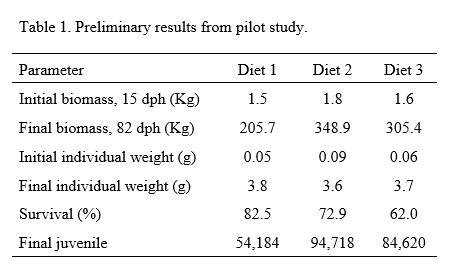PRELIMINARY RESULTS FROM A LARGEMOUTH BASS Micropterus salmoides JUVENILE PRODUCTION
The Largemouth Bass (LMB), Micropterus salmoides is a centrarchid freshwater species native to North America and the most sought-after sport fish in the U.S. In addition to being a prized sport fish, the demand for LMB in the food fish market, particularly fresh Asian markets, has increased dramatically in recent years. (Quintero et al 2017). However, unpredictable, and variable reproductive performance have been indicated as primary bottlenecks for the industry development in many cultured fish species and particularly in largemouth bass (Izquierdo et al. 2001, Hussein et al. 2020). Some of the aspects that could improve the seed quality and seed production are broodstock nutrition and feeding. Nutritional status of the brooders is critical for spawning and egg quality since nutrients are transferred from the female to the egg (Migaud et al. 2013; Izquierdo et al. 2015).
A pilot study to evaluate the impact of essential fatty acids and nucleotides in the largemouth bass spawning and juvenile production was performed. LMB brooders (300 fishes) were stocked in RAS (64.0 ±1.0 °F), and fish were fed for 92 days, with three different diets (Diet 1 - commercial diet, Diet 2 - commercial diet supplemented with fish oil and DHA, and Diet 3 - commercial diet supplemented with a mix of fish oil, DHA and commercial nucleotides).
This work presents the evaluation of the effect of the diets on the larval and early juvenile development of largemouth bass. Data collected during pilot juvenile production is presented in the table below. Currently, we are conducting growth curve evaluations and statistical analysis of data. Results of this study regarding the number of juveniles obtained for each treatment may suggest an effect of the diets in brooders, but it is not significant due to the lack of replicate tanks treated with the experimental diets .
